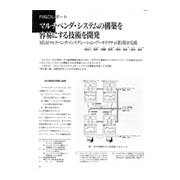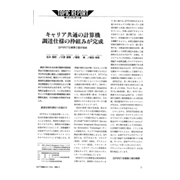The MIA (Multivendor Integration Architecture) was an application architecture defined not as a specific computer software system, but as a collection of interface specifications at the level which is directly relevant when the user constructs a system by developing applications. More specifically, it was comprised of modules such as a high-level application program interface (API), communication protocol (SII) and human interface (HUI), but the core was the API and SII. The basic concepts of MIA were as follows:
The architecture achieved not only hardware independence, but also "platform (hardware and basic software) independence" by specifying a common API and protocol covering a broad range of hardware (from the mainframes of different companies to UNIX and NT server machines) and basic software comprised of things like operating systems, DBMS and TP monitors. Thus the architecture realized a true open system capable of providing application portability, inter-operability and scalability.
The MIA Project began in the fall of 1988 as a joint development with 5 companies (IBM, DEC, NEC, Hitachi and Fujitsu) under the leadership of NTT Research Laboratories, and Version 1 of the MIA specifications was completed at the beginning of 1991. Active use of MIA as NTT's general-purpose computer procurement specification began the following ____. Starting in 1992, carriers and vendors from Japan, the US and Europe formed the SPIRIT Group within the Network Management Forum (NMF) and began stipulating cross carrier platform procurement specifications (SPIRIT specifications) based on MIA, and four versions have been drafted so far. NTT started procurement based on these SPIRIT specifications starting in 1996, and key carriers, primarily in Europe, have also used SPIRIT specifications.
To date, MIA/SPIRIT has been implemented for mainframes from IBM, DEC, NEC, Hitachi and Fujitsu, for UNIX servers from IBM, DEC, HP, Unisys, NCR and Hitachi, and NT servers from DEC, Unisys and NCR. Looking only at operating systems, the architecture covers the mainframe operating systems, UNIX and NT of 5 companies, and for TP monitors, it covers almost all the leading products in the world (mainframe specific TP monitors for 5 companies, TUXIDO, TOPEND, Encina, OpenTP).
In terms of commercial adoption, the system has been adopted primarily by Japanese and European carriers, as indicated above. In Japan it has been adopted widely for mainframes, UNIX and NT, led by NTT, and the SPIRIT specifications have been used in Europe at ETIS (the European carrier union). It has also been adopted primarily for UNIX and NT by European firms such as BT, DT, Telecom Italia and PTT Telecom. Adoption in the US has been limited.
The main goal of MIA, which is based on the above concepts, is reduction of TCO (Total Cost of Ownership) by protecting user assets, and it attempted to achieve this by enabling platform changes while preserving operability of software assets, partial subsystem changes, and continuous optimal platform procurement. Due to NTT's situation at the time, an even greater goal was ensuring simplicity and transparency in international procurement of computers, and achieving a soft landing of DIPS.



